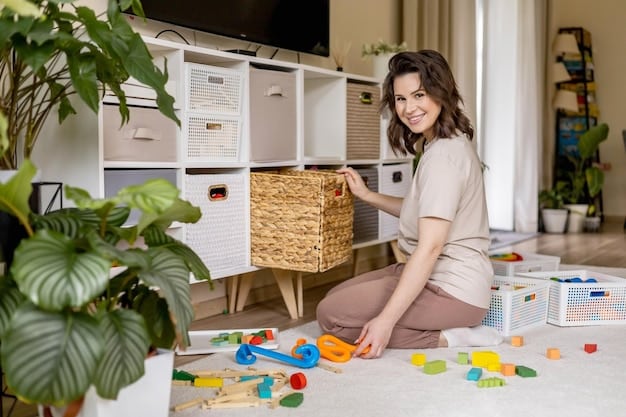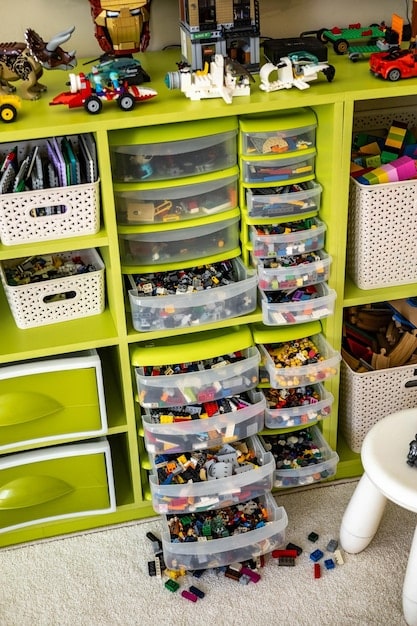Maximize Playtime: Rotate Toys Every 2 Weeks for Renewed Engagement

Maximize playtime by rotating your child’s toys every two weeks; this simple strategy renews their engagement and fosters creativity, preventing boredom and encouraging cognitive development.
Is your child losing interest in their toys? Discover how you can maximize playtime: rotate toys every 2 weeks for renewed engagement. This simple yet effective method can transform your child’s playtime, sparking creativity and preventing boredom.
Why Toy Rotation? Unveiling the Benefits
Toy rotation might sound like just another chore, but it’s actually a powerful tool for parents. Regularly changing the toys available to your child can have a significant impact on their development and engagement.
So, what are the key benefits of implementing a toy rotation strategy?
Enhanced Focus and Concentration
When children are overwhelmed with too many choices, they often flit from one toy to another without truly engaging. Reducing the number of available toys can help them focus and concentrate better.
Sparking Creativity and Imagination
A smaller selection of toys encourages children to be more creative with what they have. They’re more likely to invent new games and uses for familiar objects, fostering imagination.

- Reduced Clutter: Fewer toys out at once means less mess and easier cleanup.
- Increased Appreciation: When toys reappear after a break, children often rediscover them with renewed interest.
- Cost-Effective: You can make the most of what you already have, rather than constantly buying new toys.
Ultimately, toy rotation is about creating a more intentional and enriching play environment for your child.
Getting Started: Setting Up Your Toy Rotation System
Ready to jump into toy rotation? Here’s how to set up a system that works for you and your child.
It all starts with organization and a little planning.
Categorize Your Toys
Begin by sorting all your child’s toys into categories. This could include blocks, puzzles, dolls, vehicles, art supplies, and so on. This makes it easier to create balanced rotations.
Choose Storage Containers
Invest in storage containers to keep the rotated toys out of sight. Clear bins, labeled boxes, or even a dedicated closet can work well. The key is to make them easily accessible to you but not to your child.

- Select Toys for the First Rotation: Choose a variety of toys from different categories to keep your child engaged.
- Establish a Rotation Schedule: A two-week rotation is a good starting point, but you can adjust based on your child’s interest and needs.
- Observe and Adjust: Pay attention to which toys your child gravitates towards and adjust future rotations accordingly.
With a little preparation, setting up a toy rotation system can become a seamless part of your routine.
Two-Week Rotation: The Sweet Spot for Engagement
Why two weeks? This timeframe strikes a balance between novelty and familiarity, allowing children to fully explore a set of toys without getting bored.
Here’s why a two-week rotation period works so well.
Rotating toys every two weeks allows your child enough time to truly engage with each toy without becoming overly familiar or losing interest. It’s a pace that supports deeper play and exploration.
This is also a practical timeframe for most parents, allowing enough time to observe play patterns and prepare for the next rotation without feeling overwhelmed.
The Dos and Don’ts of Successful Toy Rotation
To make the most of toy rotation, keep these dos and don’ts in mind. Avoiding common pitfalls can help ensure a successful and engaging playtime experience.
Here are essential guidelines to follow and mistakes to avoid.
Do Involve Your Child (Sometimes)
While the rotation process should primarily be managed by you, there are opportunities to involve your child. Asking for their input on which toys to bring out next can build excitement and anticipation.
Don’t Introduce Too Many New Toys at Once
The goal of toy rotation is to reduce overwhelm, so avoid introducing a large number of toys simultaneously. Stick to a manageable selection that encourages focused play.
It’s important not to surprise your child with all of the new options. They will appreciate knowing what to expect when they go in for a play-date or playtime.
- Do Observe Your Child’s Play: Notice which toys capture their attention and which ones are ignored. This feedback can inform future rotations.
- Don’t Forget About Educational Toys: Include toys that promote learning and skill development in each rotation.
- Do Clean Toys Regularly: Before storing toys, give them a quick wipe down to keep them clean and hygienic.
Following these guidelines can help you create a toy rotation system that is both effective and enjoyable for your child.
Making Toy Rotation Fun and Exciting
Toy rotation doesn’t have to be a mundane task. With a little creativity, you can make it a fun and exciting experience for both you and your child.
Turn rotation day into an event that your child looks forward to.
Create a “New Toy Day” Ritual
Designate a specific day for rotating toys and make it special. You could create a little ceremony or celebration each time new toys are introduced.
Tell Stories About the Toys
When introducing rotated toys, tell stories about them. Where did they come from? What adventures have they been on while in storage? This can spark your child’s imagination.
Try to create short, unique experiences. Use this day as a core memory for you and your child.
- Incorporate Themes: Rotate toys around a specific theme, such as animals, vehicles, or colors, to add extra excitement.
- Build Anticipation: Give your child hints about what new toys are coming out to build excitement.
- Make It a Shared Activity: Involve your child in the process of selecting and organizing toys for the next rotation.
By adding a touch of fun and excitement, you can transform toy rotation into a positive and eagerly anticipated event.
Long-Term Benefits: Nurturing Development Through Play
The benefits of toy rotation extend far beyond just keeping your child entertained. It can also have a profound impact on their long-term development.
Consistent toy rotation fosters a range of valuable skills and abilities.
By encouraging children to focus, create, and problem-solve, toy rotation supports cognitive development and lays the foundation for future learning.
Additionally, the structured play environment created by toy rotation can help children develop independence and self-direction.
- Cognitive Development: Encourages problem-solving and critical thinking skills.
- Emotional Development: Fosters independence, self-direction, and emotional regulation.
- Social Development: Promotes cooperation, sharing, and communication skills through collaborative play.
Toy rotation is an investment in your child’s future, nurturing their development and preparing them for success in all areas of life.
| Key Point | Brief Description |
|---|---|
| 🔄 Renewed Engagement | Toys feel new again, sparking fresh interest. |
| 🧠 Focus & Creativity | Less clutter boosts concentration and imaginative play. |
| 🧹 Organized Space | Rotating toys reduces mess and simplifies cleanup. |
| 🌱 Long-Term Development | Fosters cognitive, emotional, and social growth. |
Frequently Asked Questions (FAQ)
▼
A two-week rotation is a great starting point, but you can adjust based on your child’s interest. Some children may benefit from a weekly rotation, while others may prefer a longer period of three to four weeks.
▼
Rotate a variety of toys from different categories to keep your child engaged. Include a mix of educational toys, building toys, imaginative play toys, and art supplies to provide a well-rounded play experience.
▼
Store the toys in labeled bins or boxes in a closet, attic, or basement. Choose storage containers that are easily accessible to you, but out of sight for your child to maintain the element of surprise.
▼
Yes, involving your child can build excitement and anticipation. Ask for their input on which toys to bring out next or let them help with organizing and cleaning the toys before they go into storage.
▼
Explain that the toy is taking a “rest” and will come out again soon. You can offer a similar toy that is currently available or suggest a new activity to distract them. Consistency is key!
Conclusion
Implementing a maximize playtime: rotate toys every 2 weeks for renewed engagement can significantly transform your child’s playtime, fostering creativity, focus, and appreciation for their belongings. By strategically managing their toy selection, you’re not just reducing clutter but also enriching their developmental journey. Start today and watch as your child rediscovers the joy of play, over and over again.





